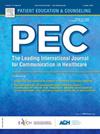Exploring the state of shared decision-making in head and neck oncology: Assessing treatment communication
IF 2.9
2区 医学
Q2 PUBLIC, ENVIRONMENTAL & OCCUPATIONAL HEALTH
引用次数: 0
Abstract
Objective
To explore the state of shared decision-making (SDM) in head and neck (HN) oncology by investigating the extent to which SDM is currently employed by HN surgeons and how the perceived levels of SDM relate to the observed levels of SDM. Additionally, surgeon and patient perspectives on patient involvement in SDM and potential associations with observed levels of SDM were explored.
Methods
Perceived level of SDM and patient involvement were measured by SDM-Q-9/SDM-Q-Doc resp. Control Preference Scale. Observed SDM was measured by analyzing audiotaped consultations (N = 42) using the OPTIONmcc+ instrument. Univariate linear analyses were conducted to identify possible associations with surgeon-observed SDM.
Results
Median perceived SDM scores of surgeons (74.4 %) and patients (71.1 %) were relatively high, whereas observed median OPTION-scores were moderate (surgeons 48 %, patients 42 %, caregivers 24 %). Consultation time and patient OPTION-score were positively associated with surgeon OPTION-score.
Conclusion
Surgeons and patients seem to overestimate the extent of SDM compared to the observed reality. Patients’ goals, values and preferences need to be addressed more during consultations.
Practice Implications
The findings can be used to raise awareness of SDM among surgeons to improve their skills. Routine training in medical education can benefit from effective integration of SDM principles during consultations.
求助全文
约1分钟内获得全文
求助全文
来源期刊

Patient Education and Counseling
医学-公共卫生、环境卫生与职业卫生
CiteScore
5.60
自引率
11.40%
发文量
384
审稿时长
46 days
期刊介绍:
Patient Education and Counseling is an interdisciplinary, international journal for patient education and health promotion researchers, managers and clinicians. The journal seeks to explore and elucidate the educational, counseling and communication models in health care. Its aim is to provide a forum for fundamental as well as applied research, and to promote the study of organizational issues involved with the delivery of patient education, counseling, health promotion services and training models in improving communication between providers and patients.
 求助内容:
求助内容: 应助结果提醒方式:
应助结果提醒方式:


